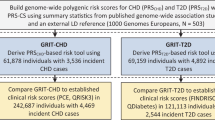Abstract
The most common diseases affecting middle-aged and elderly subjects in industrialized countries are multigenetic and lifestyle related. Several attempts have been made to study interactions between genes and lifestyle factors, but most such studies lack the power to examine interactions between several genes and several lifestyle components. The primary objective of the EpiHealth cohort study is to provide a resource to study interactions between several genotypes and lifestyle factors in a large cohort (the aim is 300,000 individuals) derived from the Swedish population in the age range of 45–75 years regarding development of common degenerative disorders, such as cardiovascular diseases, cancer, dementia, joint pain, obstructive lung disease, depression, and osteoporotic fractures. The study consists of three parts. First, a collection of data on lifestyle factors by self-assessment using an internet-based questionnaire. Second, a visit to a test center where blood samples are collected and physiological parameters recorded. Third, the sample is followed for occurrence of outcomes using nationwide medical registers. This overview presents the study design and some baseline characteristics from the first year of data collection in the EpiHealth study.
Similar content being viewed by others
References
Marras C, Goldman SM. Genetics meets environment: evaluating gene–environment interactions in neurologic diseases. Semin Neurol. 2011;31(5):553–61.
Renz H, Autenrieth IB, Brandtzaeg P, et al. Gene–environment interaction in chronic disease: a European Science Foundation Forward Look. J Allergy Clin Immunol. 2011;128(6 Suppl):S27–49.
Heim C, Binder EB. Current research trends in early life stress and depression: review of human studies on sensitive periods, gene–environment interactions, and epigenetics. Exp Neurol. 2012;233(1):102–11.
de Magalhaes JP, Wuttke D, Wood SH, Plank M, Vora C. Genome–environment interactions that modulate aging: powerful targets for drug discovery. Pharmacol Rev. 2012;64(1):88–101.
Rigoli L, Briuglia S, Caimmi S, et al. Gene–environment interaction in childhood asthma. Int J Immunopathol Pharmacol. 2011;24(4 Suppl):41–7.
Dunn EC, Uddin M, Subramanian SV, Smoller JW, Galea S, Koenen KC. Research review: gene–environment interaction research in youth depression: a systematic review with recommendations for future research. J Child Psychol Psychiatry. 2011;52(12):1223–38.
Cornelis MC, Hu FB. Gene–environment interactions in the development of type 2 diabetes: recent progress and continuing challenges. Annu Rev Nutr. 2012;32:245–59.
Lee YC, Lai CQ, Ordovas JM, Parnell LD. A database of gene–environment interactions pertaining to blood lipid traits, cardiovascular disease and type 2 diabetes. J Data Mining Genomics Proteomics. 2011;2(1):106.
Collins FS. The case for a US prospective cohort study of genes and environment. Nature. 2004;429(6990):475–7.
Ollier W, Sprosen T, Peakman T. UK Biobank: from concept to reality. Pharmacogenomics. 2005;6(6):639–46.
Gulcher J, Stefansson K. Population genomics: laying the groundwork for genetic disease modeling and targeting. Clin Chem Lab Med. 1998;36(8):523–7.
Nakamura Y. The biobank Japan project. Clin Adv Hematol Oncol. 2007;5(9):696–7.
Chen Z, Lee L, Chen J, et al. Cohort profile: the Kadoorie Study of chronic disease in China (KSCDC). Int J Epidemiol. 2005;34(6):1243–9.
Naess O, Sogaard AJ, Arnesen E, et al. Cohort profile: cohort of Norway (CONOR). Int J Epidemiol. 2008;37(3):481–5.
Stolk RP, Rosmalen JG, Postma DS, et al. Universal risk factors for multifactorial diseases: lifelines: a three-generation population-based study. Eur J Epidemiol. 2008;23(1):67–74.
Nilsen RM, Vollset SE, Gjessing HK, et al. Self-selection and bias in a large prospective pregnancy cohort in Norway. Paediatr Perinat Epidemiol. 2009;23(6):597–608.
Golding J, Pembrey M, Jones R. ALSPAC: the Avon longitudinal study of parents and children. I. Study methodology. Paediatr Perinat Epidemiol. 2001;15(1):74–87.
Landrigan PJ, Trasande L, Thorpe LE, et al. The national children’s study: a 21-year prospective study of 100,000 American children. Pediatrics. 2006;118(5):2173–86.
Keil T, Kulig M, Simpson A, et al. European birth cohort studies on asthma and atopic diseases: II. Comparison of outcomes and exposures: a GA2LEN initiative. Allergy. 2006;61(9):1104–11.
Inskip HM, Godfrey KM, Robinson SM, Law CM, Barker DJ, Cooper C. Cohort profile: the Southampton women’s survey. Int J Epidemiol. 2006;35(1):42–8.
Almqvist C, Adami HO, Franks PW, et al. Lifegene: a large prospective population-based study of global relevance. Eur J Epidemiol. 2011;26(1):67–77.
Friberg L, Engdahl J, Frykman V, Svennberg E, Levin LA, Rosenqvist M. Population screening of 75- and 76-year-old men and women for silent atrial fibrillation (STROKESTOP). Europace. 2013;15(1):135–40.
Wiberg B, Lind L, Kilander L, Zethelius B, Sundelöf JE, Sundström J. Cognitive function and risk of stroke in elderly men. Neurology. 2010;74(5):379–85.
Carlsson L, Lind L, Larsson A. Reference values for 27 clinical chemistry tests in 70-year-old males and females. Gerontology. 2010;56(3):259–65.
Davey Smith G, Ebrahim S, Lewis S, Hansell AL, Palmer LJ, Burton PR. Genetic epidemiology and public health: hope, hype, and future prospects. Lancet. 2005;366:1484–98.
Riboli E, Kaaks R. The EPIC project: rationale and study design. European prospective investigation into cancer and nutrition. Int J Epidemiol. 1997;26(Suppl 1):S6–14.
Calltorp J, Adami HO, Aström H, Fryklund L, Rossner S, Trolle Y, Giesecke J. Country profile: Sweden. Lancet. 1996;347:587–94.
Acknowledgments
We thank the Swedish Research Council for supporting the strategic research network Epidemiology for Health (EpiHealth) and thereby also the EpiHealth screening cohort.
Author information
Authors and Affiliations
Corresponding author
Additional information
Lars Lind and Sölve Elmståhl contributed equally to this work.
Rights and permissions
About this article
Cite this article
Lind, L., Elmståhl, S., Bergman, E. et al. EpiHealth: a large population-based cohort study for investigation of gene–lifestyle interactions in the pathogenesis of common diseases. Eur J Epidemiol 28, 189–197 (2013). https://doi.org/10.1007/s10654-013-9787-x
Received:
Accepted:
Published:
Issue Date:
DOI: https://doi.org/10.1007/s10654-013-9787-x




